As longtime readers know, I enjoy giving you a 'sneak peek' of my upcoming feature reviews a few weeks prior to their publication in Positive Feedback.
This time the sneak peek is of the upcoming Positive Feedback article The Triode Lab 45 EVO Single-Ended-Triode Integrated Amplifier: The Evolution of the First Watt!
Enjoy!
Publication update: The feature article about the Triode Lab 45 EVO is now live at Positive Feedback HERE.
Back in October of 2020 I did a straw poll among readers of Jeff’s Place and Positive Feedback to find out what audio products they would be most interested in having me write about.
The most popular and intriguing request among readers was the artisanal and custom-made Triode Lab 2A3 EVO single-ended-triode integrated amplifier from Frank Ng in Toronto, Canada (photo below).
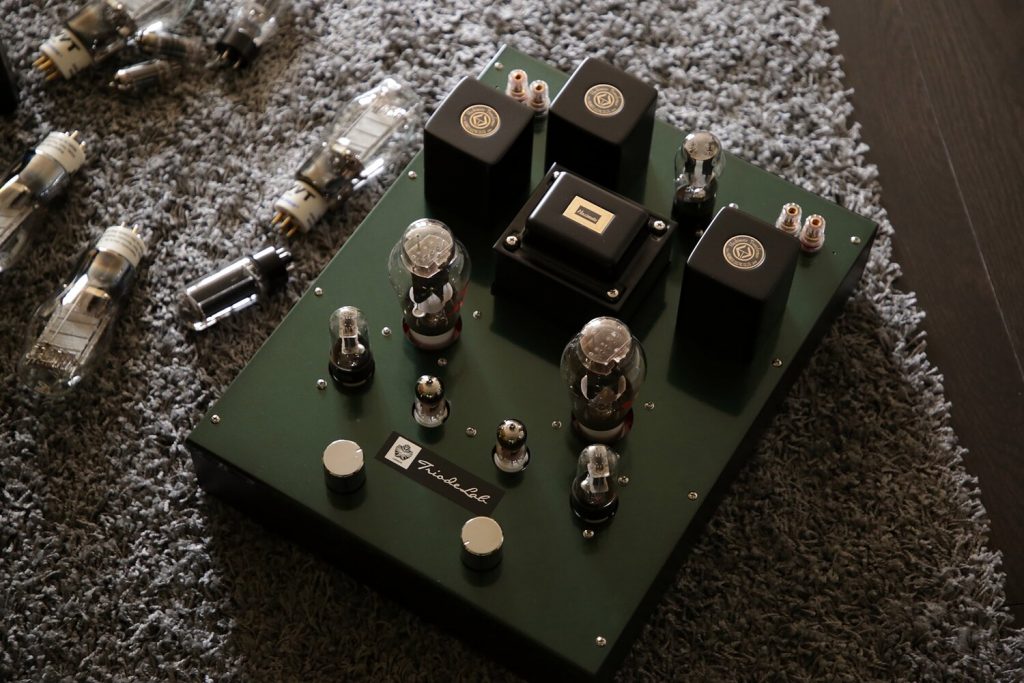
2A3 EVO integrated amplifier. Photo courtesy of Triode Lab.
I was not familiar with Frank’s Triode Lab designs, but there’s nothing I enjoy more than telling you about a new-to-me artisanal audio designer who builds state-of-art audio products, so I contacted Frank to inquire if I might write about one of his Triode Lab 2A3 EVO SET integrated amplifiers for all of you here at Positive Feedback.
Frank was very gracious in his response to my inquiry and told me he would be delighted to have me write about one of his integrated amplifiers for you.
If you go to the Triode Lab website, you’ll see that Frank offers a number of EVO integrated amplifier vacuum tube designs so as to best match the varying amplification needs of his customers.
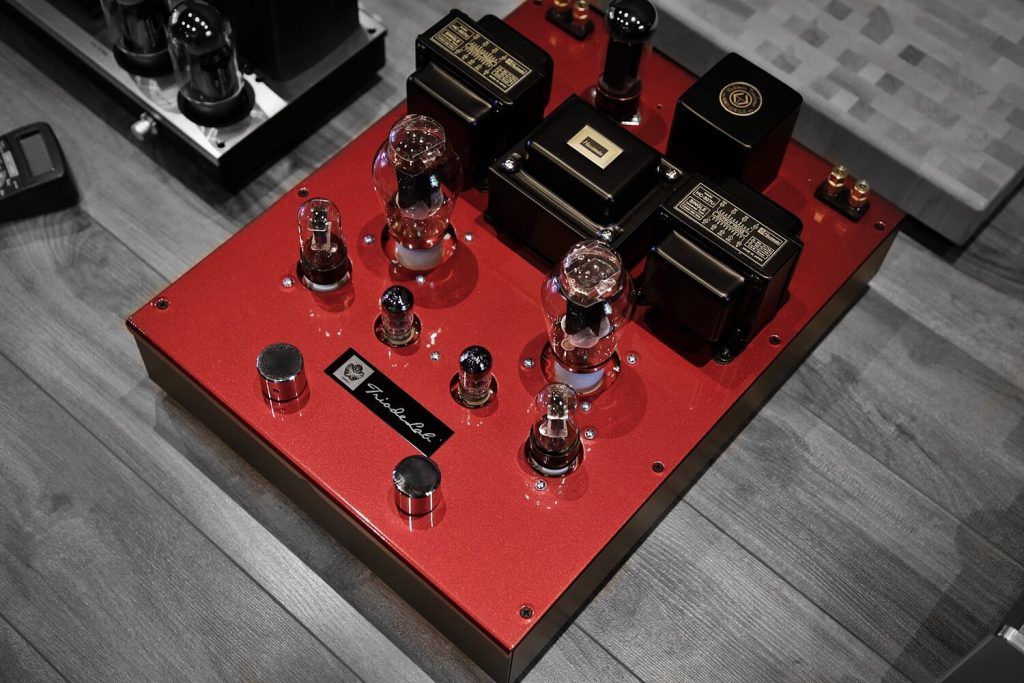
Triode Lab 45 EVO integrated amplifier. Photo courtesy of Triode Lab.
Frank currently builds EVO integrated amplifier designs based on 45, 2A3, and EL84 vacuum tubes, which are all vacuum tube types whose performance that I greatly admire.
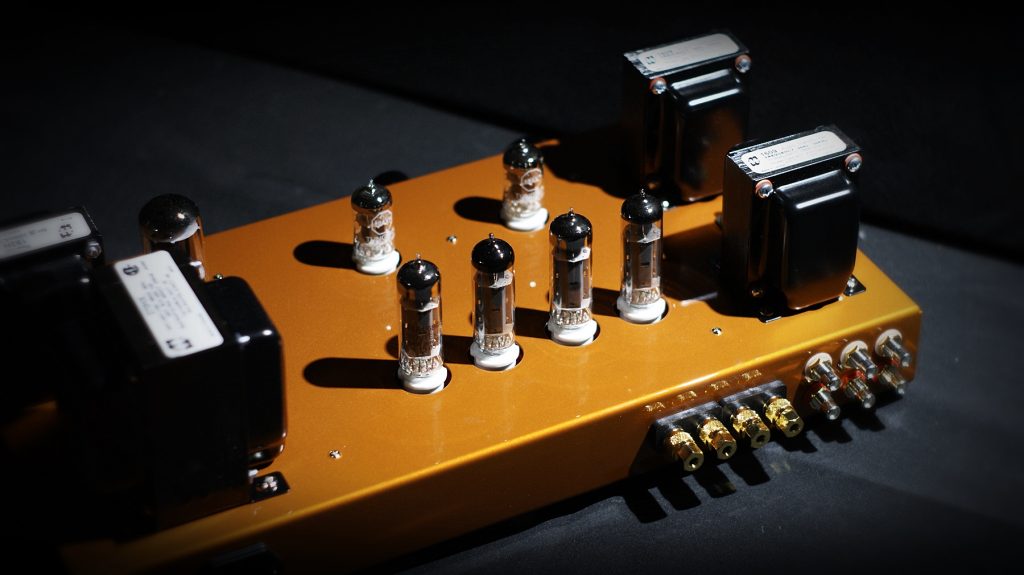
The Triode Lab EL84TT EVO integrated amplifier. Photo courtesy of Triode Lab.
I am a big fan of quality integrated amplifiers, as they can provide a huge slice of state-of-art audio performance at a more accessible price point.
In addition to his EVO integrated amplifiers, Frank also offers separates, including preamplifiers, phono stages, and a number of stereo and monaural amplifiers based on 45, 2A3, EL84, 6V6, and 211 vacuum tubes, which you can read more about on the Triode Lab website.
All of Frank’s amplifiers are custom-built to order and are custom-tailored to an individual customer’s needs and preferences.
So that I could experience the custom-tailoring process that a Triode Lab customer would experience when ordering one of Frank’s EVO integrated amplifiers, Frank suggested that I go through the same sort of custom-tailoring process that you would go through as a customer.
To start the process Frank quizzed me about my loudspeakers and audio preferences to get a better idea of what the most appropriate build and voicing for the amplifier would be.
Frank’s first question to me was about the sensitivity of my loudspeakers. Were my loudspeakers above 100dB sensitivity?
I told Frank that I had four pairs of loudspeakers that could potentially be used in the article about his amplifier. Three pairs of my loudspeakers are vintage Altec loudspeakers with sensitivities above 100dB, and I have a pair of Tannoy Westminster Royal SE loudspeakers with a sensitivity of 99dB.
Given the high-sensitivity of my loudspeakers, Frank suggested that I consider writing about the Triode Lab 45 EVO integrated amplifier instead of the 2A3 EVO integrated amplifier, as Frank thought the 45 EVO would perform at an even higher level than the 2A3 EVO with my collection of highly-sensitive loudspeakers.
I appreciated Frank’s thoughtful suggestion of steering me towards the 45 EVO for my particular collection of loudspeakers, and I followed Frank’s expert advice to get the greatest possible performance benefit out of his custom-tailoring process.
Next Frank asked me questions about the choice of output transformers for voicing the 45 EVO to best match my loudspeakers and personal tastes.
Frank utilizes the highly regarded Hashimoto Electric Co. transformers in his designs, which I might add were also the favorite transformers of the late Don Garber for select Fi designs.
Frank explained to me that Hashimoto output transformers are available in three voicing styles that will make one of them a better match to particular loudspeaker designs and listener preferences: the “Standard”, the “Classic”, and the “Combo” voicings.
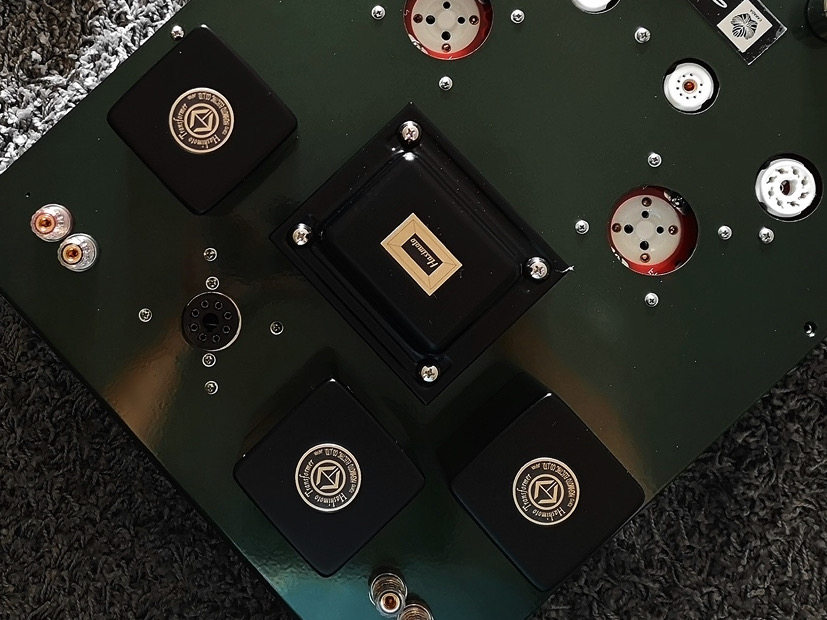
7W Standard Hashimoto potted output transformers. Photo courtesy of Triode Lab.
The Hashimoto “Standard” 7 watt potted output transformer (photo above) provides “… unrestrained highs, high-resolution of recorded nuance, pinpoint imaging, good headroom, and a big sense of space and air, making it the most realistic sounding of Hashimoto transformers …”.
Frank told me, “On smaller speakers, regular dynamic and/or bass reflex box speakers, and some hybrid horn loaded designs, etc., the 7W potted output transformer can be a better match for most of them. There are no absolute rules to matching transformers to loudspeakers, thus I used the word “most", as loudspeaker designs can vary greatly depending on their design. The driver types, the crossover type, their efficiency, the materials of driver, the resistance of the drivers, the type of capacitors, inductors, etc., all yield different outcomes.
“The 7W potted output transformer can be better for certain applications, as when the listener wants to emphasize clean and accurate transient speed, absolute pinpointing imaging, unrestrained highs, sharpness, a 3D soundscape, air and inner details, proper resonances of voices and instruments, etc. It’s another kind of beauty. There is no best this, or that, it all comes down to matching, and one's ear. Whichever output transformer type gives the listener more enjoyment wins.”
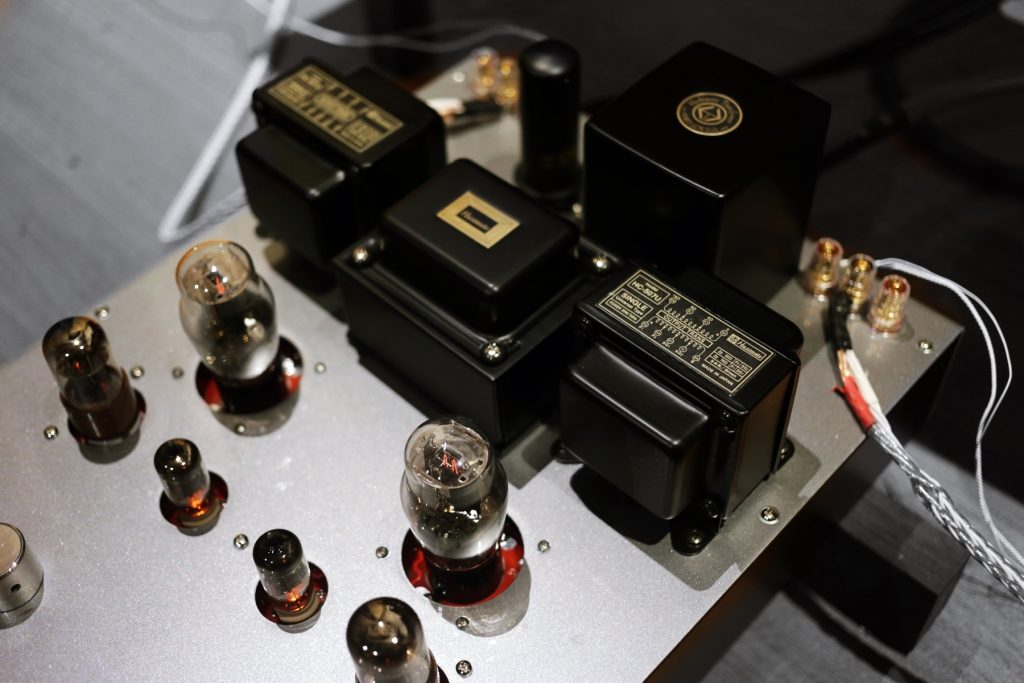
20W Classic Hashimoto output transformers. Photo courtesy of Triode Lab.
The Hashimoto “Classic” 20 watt output transformers (photo above) “… have more meat, impact, musicality, weight, and bass (they are more upfront too). It’s at its best with vintage speaker designs and horns.”
Frank told me, “The 20W Classic output transformers have a synergy for matching loudspeakers that represent "extreme conditions”. Most of the big vintage designs, or highly efficient loudspeakers, fall into this category. Here the 20W Classic output transformers will be very helpful. With better bass extension and better weight, the 20W Classic became very balanced top to bottom. The 7W output transformers's superior high-frequency and mid-range performance can become overly pronounced, especially on horns, which can make them sound too forward, and lacking in coherence.
“If we use the Tannoy Westminster loudspeakers as an example, if we match them with the 7W output transformers they will sound thinner and flat. The energy, liveliness, realism, proper weight and impact, handling capability, will be missing, which means the sense of rhythm, the sense of being there, the emotion, the swing, etc., might have a hard time being delivered thru the loudspeakers.”
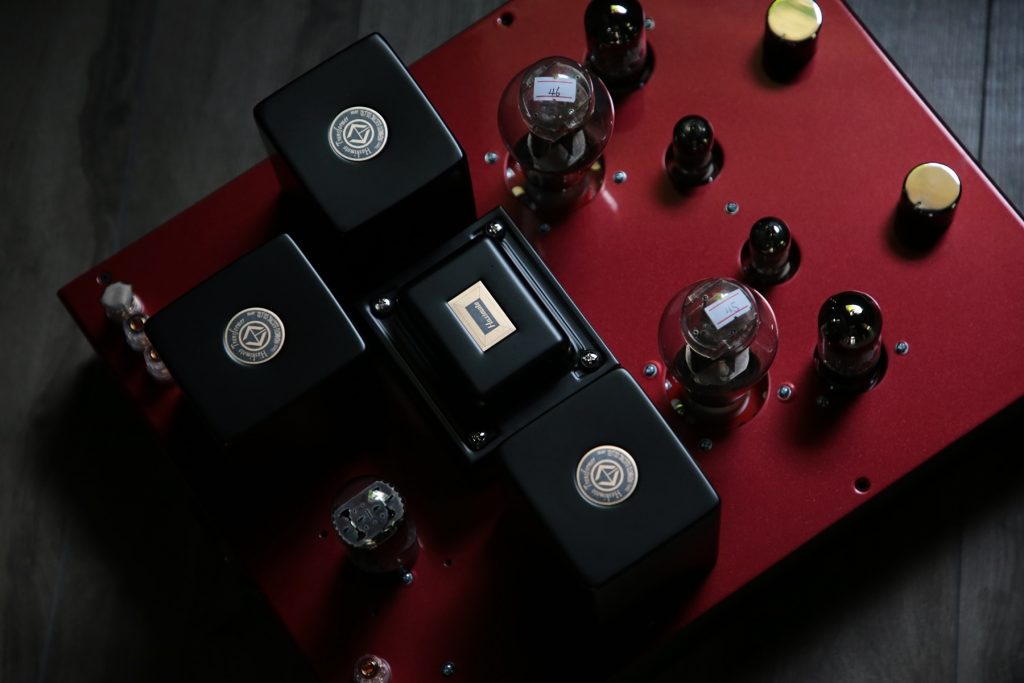
20W Combo Potted Hashimoto output transformers. Photo courtesy of Triode Lab.
The third transformer voicing is “… the bigger, better, more expensive, higher level Hashimoto Combo 20W potted output transformers.
“The 20W Combo combines the best of the 7W Standard and the 20W Classic transformers, and are almost like a hot-rod version of the 7W, with better bass performance. My experience with these three styles of Hashimoto output transformers is that the 20W Combo is too good to the point it could be too analytical and perfect on very revealing speakers. Also, the 20W Combo lacks the poise, grease, and boldness of the 20W Classic version, which could be a benefit for your vintage Altecs.
“On regular loudspeakers, the 20W Combo output transformers will definitely be an upgrade, but for the "extreme case" loudspeakers like the vintage Altecs or Tannoy Westminster loudspeakers, the 20W Classic output transformers will have a more natural flow and richer tone that matches these loudspeakers better.
“So to best match your vintage Altec and Tannoy Westminster loudspeakers, I suggest using the 20W Hashimoto Classic output transformers. It's a safer bet.”
Based on Frank’s recommendation, we went with the 20W Hashimoto Classic output transformers for the 45 EVO integrated amplifier.
In the next step of the tailoring process, Frank asked me if I would like 4 Ohms, 8 Ohms, or 16 Ohm transformer taps. Given my three pairs of vintage Altecs are all 16 Ohms, and my Tannoy Westminster Royal SEs are 8 Ohms, I opted for taps of 8 Ohms and 16 Ohms.
Frank’s final question for me was about vacuum tubes. Did I have a particular set of vacuum tubes I wanted to use?
I told Frank that I didn’t have a preferred set of vacuum tubes appropriate for the 45 EVO integrated amplifier, so to go ahead and use a choice of vacuum tubes that he thought would be a good match for my particular application.
I hope this example gives you an idea of Frank’s tailored approach to ordering a Triode Lab EVO integrated amplifier, and how Frank recommends components to optimize the performance for a particular customer’s needs and tastes.
I was particularly impressed by Frank’s thoughtful approach to recommending and voicing the Triode Lab EVO integrated amplifier to meet my particular loudspeaker needs.
If you as a customer have ideas about what might best serve your needs in an EVO integrated amplifier, ask Frank for advice on how well your ideas will work in practice, and Frank can help steer you in a good direction that best matches your needs.
I originally thought that the 2A3 EVO integrated amplifier would best fit my needs, but Frank steered me towards the 45 EVO integrated amplifier for my collection of loudspeakers, and I am glad I listened.
Now allow me introduce you to Frank Ng and Triode Lab.
Frank Ng and Triode Lab
One of my favorite aspects of writing about high-performance audio is telling you about the people behind the designs, so I asked Frank if he would share with us a little about himself, how he got started in audio, and his vision for Triode Lab.
“When asked to give an introduction about myself as the “face behind the brand” I much prefer to introduce my hardworking team, without whom, Triode Lab and Finale Audio would not be possible.
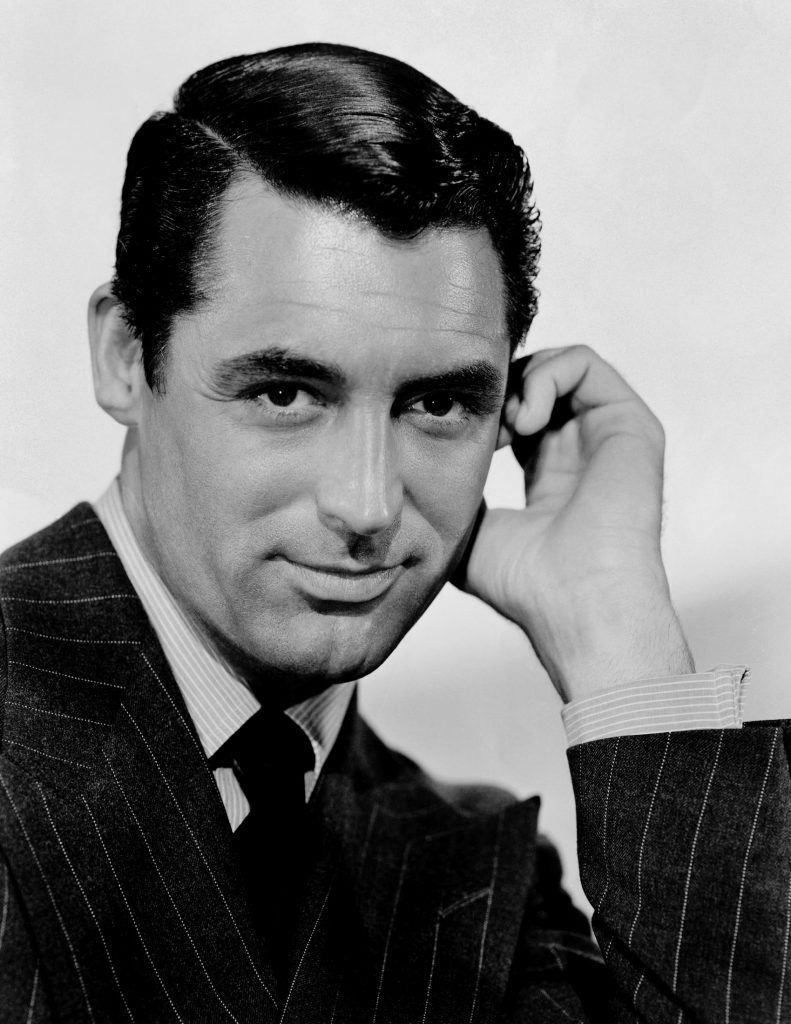
Frank Ng, aka Cary Grant. Public domain photo courtesy of Wikipedia.
(Note: As is my custom, I asked Frank if he would send me a photo of himself so I could introduce him to you, but he was shy and demurring, saying, "I would much appreciate being anonymous because I'm simply not good looking ...". I tried to encourage Frank that was ok, we would appreciate him all the more, as after all, more than a few audio designers are known to look a bit like mad scientists, and indeed, I am actually a mad scientist (albeit a retired one). I substituted a photo of Cary Grant, who is rumored to look very much like Frank. - Jeff)
“Looking back on my humble journey, I have always had more “refined” taste in music than the typical audiophile. As a child, I was very fortunate to be exposed to what “hi-fi” is all about, since many in my social circle of family and friends all had “high-end” audio systems. In fact, even after so many decades, most of these brands are still considered to be top-tier. However, the more I listened, the less these major brands of amplifiers satisfied my needs. Thus, I knew I had to create my own ‘standard of sound’, one which I would be proud to share with others someday.
“Now, my ‘discerning ears’ are not merely a result of listening to countless hi-fi amplifiers on the market, they also come from my music training, as I have been playing piano since the age of 7, along with some guitar and violin.
“Given my background, my first instinct when listening to an amplifier is to consider how real the instruments and vocals sound. For instance, does the piano sound like a digital keyboard, or a violin sound like a viola, because the amp's frequency started to roll off early, or do the guitar chords sound “muddy” and slow? To me, a bad amp is evident when music playback lacks range, while a good amp can always to deliver both staccato and legato, doing great justice to the genuine emotions of the music itself.
“In the early 2000s, a few close friends whose careers are all in the electronics sector (audio and communication engineers, electrical and computer engineers, and industrial designers), and I, decided to get together to make our audio dream happen. We started by designing and manufacturing mass-produced radios, auto and marine amplifiers, toy- and computer-related sound products, custom electronics for radio stations and studios, and even communication electronics for larger vessels and towers. All of us were familiar with and skilled in solid-state designs from the “golden-age era of solid state electronics” from the early 80s and 90s.

“We were also especially fond of triode tubes, due to how realistically they play back the music, so we used our knowledge to launch high-performance vacuum tube amplifiers. Although these designs were not suitable for mass production or profit-making, we still wanted to go ahead because we knew that audiophiles like ourselves would enjoy them.
“The next step involved spending endless hours voicing every amp, fine tuning everything from hardware choices to passive parts values. Each model of a transformer, or even an individual capacitor can sound dramatically different in our circuits. I fondly recall those days where I would often have stimulating discussions and heated debates about various settings for better measurements and specs. Without a doubt, my main objective would always be achieving the best sound.
“Once, for a 45 EVO, I insisted on using 5K primary impedance output transformers (versus the 2.5-3.4K most often used) for a better and livelier sound, lower distortion, improved balance and weight, and more consistent delivery with different 45 tubes (particularly with older and new old stock tubes). In my opinion, the benefits in running 5K primary impedance far outweighs the very minimal wattage loss in returns. Running a lower impedance not only means a flatter and duller sound, but there is also less involvement, dynamics, excitement, harmonics, and tempo.
“Our goal at Triode Lab and Finale Audio was to evolve every vacuum tube design we make to get the best out of today’s modern hi-fi equipment and music. This means low distortion, wide band-width frequency, quiet and reliable operation, all for which we are known. Our vacuum tube designs must also measure well with good performance and specifications.
“What’s more, given we are playing music with the amp for pleasure, and not for the test bench, so good balance, dynamics and harmonics are all important aspects as well.
“We strive to deliver an audio experience that resembles a ‘live’ performance. In fact, this is exactly what makes a good hi-fi tube amp, not something that measures perfectly on the test bench but sounds ‘dead’ when playing music. We want to turn the audio signal into actual music.
(Note: The “EVO” in Triode Lab products nomenclature represents the evolution in performance that is possible with the best vacuum tube designs of today. By analogy, if a 1920s 45 single-ended-triode amplifier represents an early hominin fore-bearer, then the Triode Lab 45 EVO represents the more “evolved” example of modern humans. - Jeff)
“Despite there being many amplifier applications for different uses like accuracy, or loud volumes, and so on, my team and I specialize in making hi-fi amplifiers that play music well for home applications.
“Professional uses for studios, sound chambers, radio stations, concert halls, stages, or movie theaters entail a different design mindset, so the outcome may not be optimal for home use.
“For instance, tube amps for movie theaters are more likely to be designed in higher power Class AB mode due to heat, efficiency, and prolonged usage concerns. Some audiophiles may not realize each amp’s and speaker designs exists for a specific purpose or application.
“For example, take horn speakers: some are used for performing arts, or public address systems for speech, like Klipsch, where they can also be seen on warships and aircraft carriers, and even for presidential speeches. Western Electric and Altecs are common for theaters, communication channels, and for musicals, while JBL and TAD are often designed for home theaters and studios.
“So now, 20 years after the Y2K, many amplifier manufacturers are still using designs from the 50s or 60s, the mono era. We do our best to ensure that each of our designs are totally evolved to meet today’s standards in comparison.
“If we must give a name to our sound, we can call it a ‘touch of modern hi-fi flavor’, or something a bit fancier, like ‘Triodeism’. Either way, we pride ourselves in delivering realistic fine audio playback with a hint of the past, but perfect for today’s high definition and wide-bandwidth recordings. The amplifiers won't be shy in the bass nor will their highs be rolled off pre-maturely (back in audio history, the bandwidth of sources was narrower). Most of all, the range of variations in music will be presented, providing that sense of being there.
“Today's expectations for reliability and operational noise are at much higher standards than those of the past, so auto-bias for tube amplifiers today is a must.
“When we design an amp, we put the needs of our customers first, and the ease of use of the amplifier for the listener will always be on top of our priority list. We firmly believe this is the best way to connect fine analog music to the end user at home. So, if an amplifier is hard to operate or maintain, then, we have not been successful in our product design, and must go back to the drawing board once again.
“To close, at Triode Lab and Finale Audio, we are not driven by profits. Rather, we are passionate about sharing a better sound experience through our evolution-ized tube designs with higher fidelity.
“Importantly, as a Canadian entrepreneur, I wish to support our local audio industry, and continuously create and promote more opportunities for this trade. All our parts, the most authentic and the best, are sourced through North American distributors, while all the chassis and shipping boxes are made right here in Toronto. Each amp we build is the result of the efforts of about ten different companies, the hands of twenty to thirty Canadians.
“The process is as follows: first, my chassis design sketches are sent to the CNC drafter and designer, then after that step the chassis designs go to half-a-dozen metal workers. After that the chassis go through a quality control inspection, and packing. They are then sent to the painter's shop. Each of our parts distributors are involved, and likely another dozen at Hammond, and, of course, our team at Triode Lab.
“While I’m not earning much money from my audio ventures, I’m still very happy with the outcome because I get to satisfy my passions as an audiophile and music lover, and as an entrepreneur!
“The last two decades or so have been challenging, trying to cope with inexpensive products made offshore. In addition to Triode Lab and Finale Audio, I have also been running my other manufacturing business, which specializes in high-fashion garments, with nearly a hundred hard-working Canadians employed prior the recent Covid-19 pandemic.
“I'm glad we’re finally “seeing the light at the end of the tunnel” as many consumers have returned to buying local, or, at least, North American made products. Time has certainly proven that my determination to succeed, and my ongoing efforts, have led to some of the best quality Canadian-made products.
“Last, but not least, I would like to take this opportunity to express my sincerest gratitude to my team of dedicated professionals, for doing exactly what they are good at, and also for helping me in realizing my life dream of building fine audio products. The last ten years have been wonderful, and I look forward to the next ten years of this exciting journey!”
The Triode Lab 45 EVO Single-Ended-Triode Integrated Amplifier
The 45 EVO single-ended-triode integrated SET amplifier’s base price is $7500 USD, which includes world-wide shipping, one new set of preferred tubes, and a power cord (HERE) & speaker cables (HERE) produced by Triode Lab.
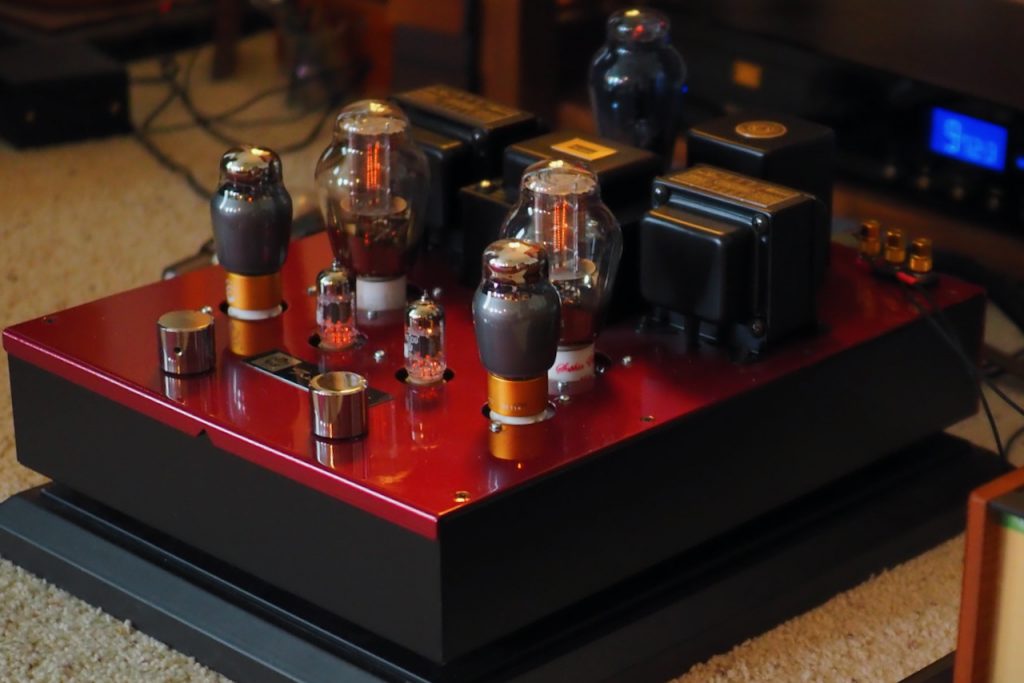
The Triode Lab 45 EVO integrated SET amplifier.
The 45 EVO integrated amplifier in this article also included the optional custom automotive Ferrari Rosso Fiorano paint finish, which is a $1000 USD up-charge, with the total price coming to $8500 USD.
The 45 EVO utilizes a vacuum tube complement of two 12AX7s, two 6SN7s, two 45s, and a single rectifier. A variety of rectifiers can be used in the 45 EVO, such as the GZ32, 5V4, 5T4, 5U4, or 274B, for example. However, I recommend a 274B rectifier for the 45 EVO, as 274B rectifiers provided considerably better performance than any of the other types of rectifiers I tried in the 45 EVO.
The 45 EVO features Class A autobias for 2 watts per channel output. The design of the 45 EVO will allow for the substitution of 2A3s for the 45s to provide 3 watts per channel output for those who wish to experiment.
The parts complement for the Triode Lab 45 EVO integrated amplifier in this article is as follows: Hashimoto Classic output transformers, Hashimoto choke transformer, and Hashimoto 45/2A3 power transformer, QQQ rectifier tube sockets, two pairs of CMC gold-plated RCA inputs, Cardas gold-plated binding posts, Mundorf silver PIO coupling capacitors, an Alps Blue volume control, a Lorlin selector switch, and a Furutech gold-plated IEC AC inlet.
This is Frank's recommended parts complement for the Triode Lab 45 EVO integrated amplifier, along with the Hashimoto Classic output transformers - with 8 Ohm and 16 Ohm taps - that Frank recommended as the best match for my loudspeakers.
The 45 EVO is available in 9 stock colors at no charge, and in custom colors for an up-charge (more information HERE).
The 45 EVO integrated amplifier is also available in a “Reference” configuration starting at $8,888 USD. The Reference version of the 45 EVO is equipped with 20W Hashimoto transformers, a large-sized Hashimoto choke transformer; Furutech Type 803, Audio Note (UK) Meishu, or Cardas rhodium binding posts; a DACT selector, Mundorf supreme EVO silver and gold coupling caps, a Furutech rhodium AC inlet (or optionally gold), and an automotive paint finish (like the custom Ferrari Rosso Fiorano paint finish on the 45 EVO in this article).
Given that the 45 EVO parts complement is customizable based on a particular customer’s specialized needs or desires, I recommend that you discuss any options you are considering with Frank to make sure it is a good match for your intended purpose.
I asked Frank if he would share with us some more detail about his design of the Triode Lab 45 EVO single-ended-triode integrated amplifier.
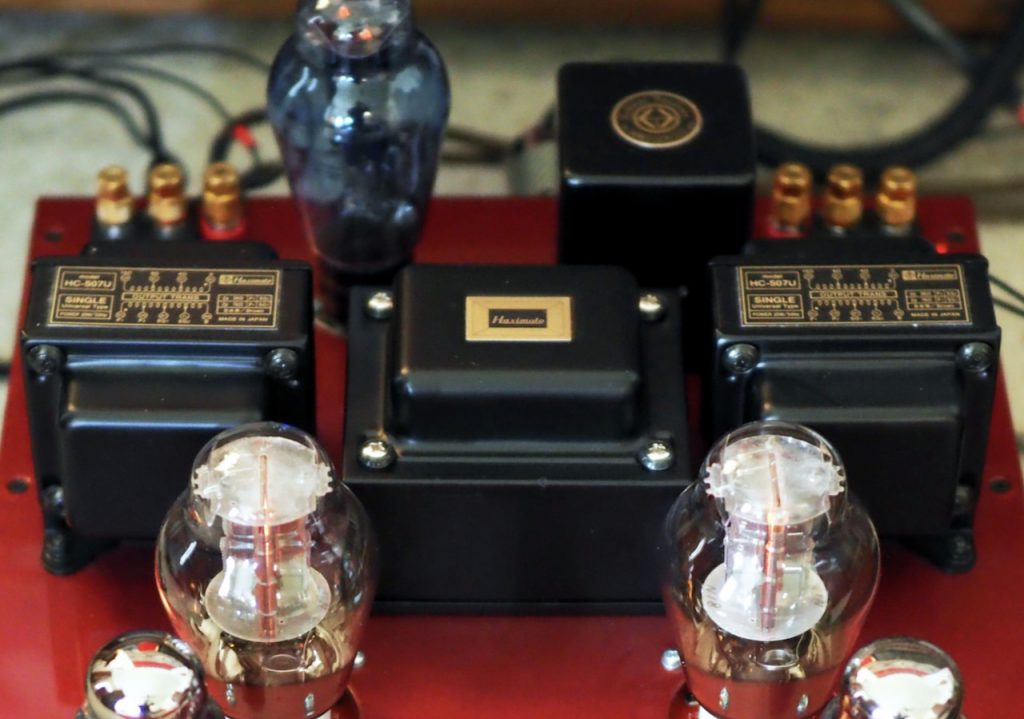
“First, we want our designs to have the best transformers available, which are the Hashimoto Electric Co., Ltd, transformers (Hashimoto has been making transformers since 1958, and you can read more about their history HERE - Jeff).
“Many audio enthusiasts already know that without good transformers, the SET amp they are listening to cannot be at its best, as the ability to unleash the full performance of a circuit and the vacuum tubes is dependent upon the transformers used.
“Transformers are like the transmissions of race cars. You can have a very fast engine, but to deliver the full potential of the engine the transmission must be a good match to the characteristics of the engine.
“The same principle applies to a vacuum tube amplifier, particularly SET designs. Good transformers allows for better highs and lows, and maintains the power output. A lot of mass produced tube amps do not make their claimed power due to the insert loss of their average grade output transformers, as well premature distortion. Also, the ability to give listener the realistic rhythm and coherence thru good dynamics and harmonics depends on the quality of the transformers. Without the full highs, lows, power output, dynamics, and harmonics, the playback can sound dull and un-involving, flat and un-lively, and sound like an unrealistic “mock-up” of the music.
“Throughout the years there have been plenty of high-end transformer companies. Over the last few years most of them have closed or have stopped production, as the demand for high-quality transformers for vacuum tube amplifiers is at an all-time low, and transformers are challenging to make, and the cost of making them is high.
“I spoke with a few managers of these high-end transformer companies. They explained that finding skilled labour is a big challenge for them, as there are few people who know how to design quality hifi transformers anymore, and fewer who can wind and produce them. Also, the stricter environmental laws mean that companies would have to spend a lot of money for cleaner machinery and production facilities to produce low volumes of transformers, making it financially prohibitive.
“Fortunately, Hashimoto Electric Co. in Tokyo are real experts in designing and manufacturing high-quality transformers for vacuum tube amplifiers. We have had experience with Hashimoto transformers for decades, and they are one of the few real experts in tube transformer design that still exist today, and are my preferred choice for transformers.
“There are some companies offering transformers with incredible specifications for wider bandwidth, or that are made from rare materials, but there is more to transformer performance than just impressive numbers. Playing music well also requires transformers to have good balance, with dynamics and harmonics that gives the music a real or life-like feeling, so that it can deliver a sense of musical authenticity to the listener, that "being there" feeling.
“So designing transformers that provide good music playback that is involving emotionally and enjoyable over the long haul is not just about specifications numbers, it starts at the very beginning of the design process with designers that know how music sounds in the first place, versus just looking at performance graphs. In short, the design and production of quality hifi transformers is becoming a lost art.
“Using the car analogy again, a car that can only go fast in a straight line doesn't make it the best car. A car that is fast and also has good handling in the corners, and is built with quality, refinement, reliability, and charisma in mind, will be the better car, and have the ability to become a future classic.
“Hashimoto transformers are like that. They give you the best balanced transformer package for music, along with the Japanese excellence of craftsmanship and reliability. Hashimoto made the transformers for the old Sansui receivers, and even after half a century many are working fine today, proving their quality and reliability.
“Lets talk about other factors that have shaped the design of the 45 EVO.
“For many years, low-efficiency loudspeakers dominated the market. Now, twenty years after the second millennium of Y2K, high-efficiency loudspeakers have made a comeback. Horns, full-range drivers, coaxial, dual-concentric, and more dynamic boxed speakers with high-efficiency are being made today.
“Many consider the 2A3 to have a very low wattage output. However, with a well built 2A3 amp it can have too much power for some high-efficiency loudspeaker applications. The volume can crank up high too early, with anywhere from 3.5W to over 5W (before distortion starts to kick in).
“The power rating depends on both the circuit setup and the output transformer, as every single output transformer has different insertion losses and other technical parameters. Subjectively, some transformers have more bass and “meat”, and some will have better highs, or a more free-flowing sound, etc. They will all measure differently in terms of output power on the same circuit. With not so well-designed 2A3 amps, we've seen and measured just 1.5W of output power before distortion and noisy operation kicks in.

“The 45 became the perfect solution for that all-important first watt in playing music, with the second watt doing the rest (above). Both watts are crucial, speaking from a quality perspective. The 45 triode became the natural choice, being durable, offering lower distortion, and making it easier to achieve a wide bandwidth frequency response, which contributes a 'live like' sound quality. The 2A3 is a cousin of the 45, but it is a totally different tube, and needs a different parts complement to unleash its full potential.
“Are triode tubes the answer for everything? Like everything else, triodes have their limitations. In the case of these ancient triode tubes that were born in the 20-30s, they have very low-efficiency. So when we design around with these triode tubes, we need to make sure to use preamp tubes that have a good enough voltage range to drive them. Although, these triodes are on the lower side of efficiency compared to newer and other types of power tubes, there are still many choices of tubes to use as the driver, and the 6SN7 / CV181 is one of them. We like the 6SN7 / CV181 very much with its good-ole tube sound and flavor, over the more controlled and quieter 9-pin preamp tubes. The 9-pin preamp tubes are sometimes too “perfect” or synthetic sounding for tube connoisseurs. Like the triode tubes, the 6SN7 is also a very rugged and durable tube. Getting a quiet 6SN7 is difficult today. Recently we bought 10 new premium versions of 6SN7s, and 6 of them we tested were microphonic, and we had to send back.
“Now, with the 6SN7 driving the 45, it already makes for a very good power amp combo, but you still can’t hook a source up to it directly and expect to get the kind of performance we want to achieve. It could provide enough volume or gain, but would not have enough signal sensitivity to recreate the realistic dynamics and harmonics of the music.
“The control would be lacking with just the 6SN7 driving the 45 triode. Imagine that for all types of loudspeakers, with all types of efficiency, with all types of materials, and with all types of presentations, that some will require more control than others. A good amp design must cover as many loudspeakers as it sees in reality, both in sound quality and and in its ability to control them. Without an extra stage of preampfification in the front end, this amplifier will sound slower and not have enough gain for line-level sources to have proper volume.

“That is why we use two 12AX7 (our design reference) or 12AU7 in the front end. While one 6SN7 would be enough for driving both channels, adding the 12AX7/12AU7 gives better control, better channel separation, and a better cross-talk ratio as well. No money is spared to achieve the best design.
“With all these concepts and goals implemented into the design of the 45 EVO, it's a true reference grade integrated amplifier. A real high-quality tube amplifier needs to sound good and measure well.
“The more technical aspects of the circuit are that the driver uses an SRPP type design, and the front-end stage uses RC coupling for lowest loss (more Class A), better design efficiency, and to more easily control optimal outcomes. We wanted wide bandwidth over high gain, since higher gain means less wide bandwidth. The design also incorporates auto-bias, which absorbs and works with fluctuations from the external power supply, which affects the operation voltage point in the circuit itself. The auto-bias also helps stabilize the operation at start-up during the warm-up period, making the playback more consistent and focused. Even after the amplifier is warmed up, auto-bias makes the sound signature of the amplifier more consistent, always giving the same sound quality in listening sessions. Last but not least, as the vacuum tubes age, and cannot maintain their specifications and voltage, this approach provides more safety and reliability.
“All of these technical notes aside, let me say that while the Triode Lab 45 EVO is a reference-level single-ended-triode design in its performance, it is also a very reliable and user-friendly design, which is a priority for us. Ease-of-use, maintenance-free operation as vacuum tubes age, and long-term reliability are all aided by autobias in the 45 EVO, delivering to the owner more long-term satisfaction.”
Review Systems
Over the time period that I’ve had the Triode Lab 45 EVO single-ended-triode integrated amplifier here, I’ve listened to it in three different audio system contexts.
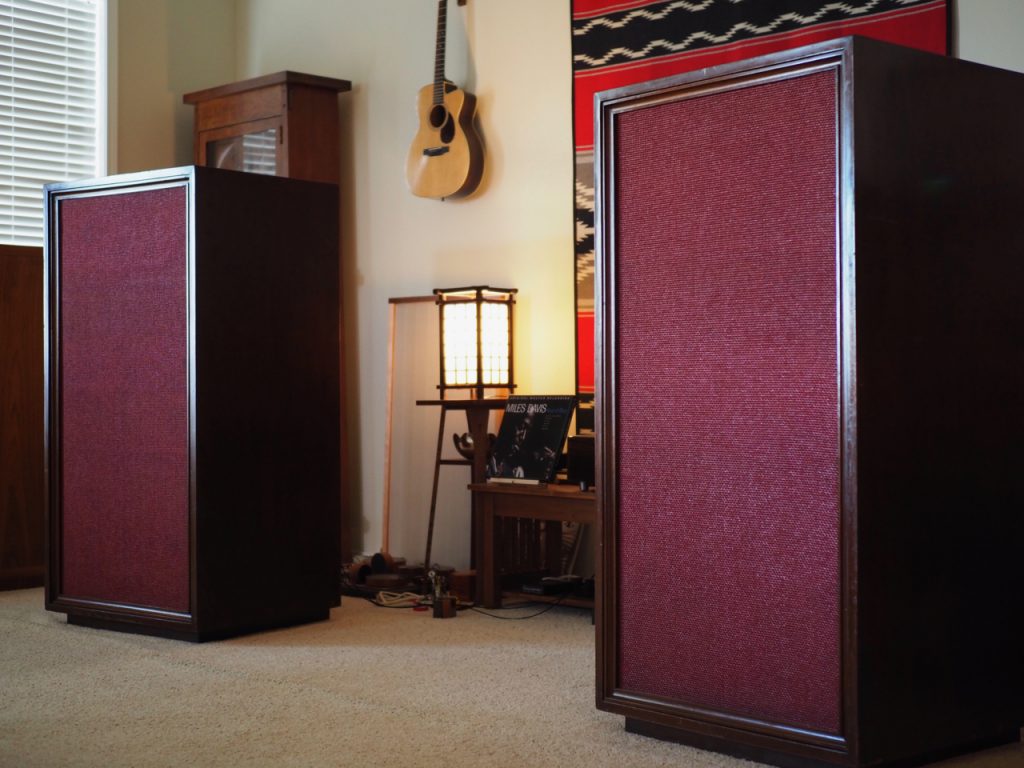
Vintage custom Altec loudspeakers built for conductor Leopold Stokowski.
The first system being my vintage Altec loudspeakers that were custom built for conductor Leopold Stokowski back in the early 1960s, and which were updated with custom Duelund CAST tinned-copper crossovers developed by Frederik Carøe (Duelund Coherent Audio) and myself for the Duelund-Altec Project (HERE).
The combination of the 45 EVO with the highly-sensitive Duelund-Altec Project “Stokowski” Altec loudspeakers provided extraordinary results, and delivered a classic “goosebumps” listening experience that both thrilled and amazed me during listening sessions.
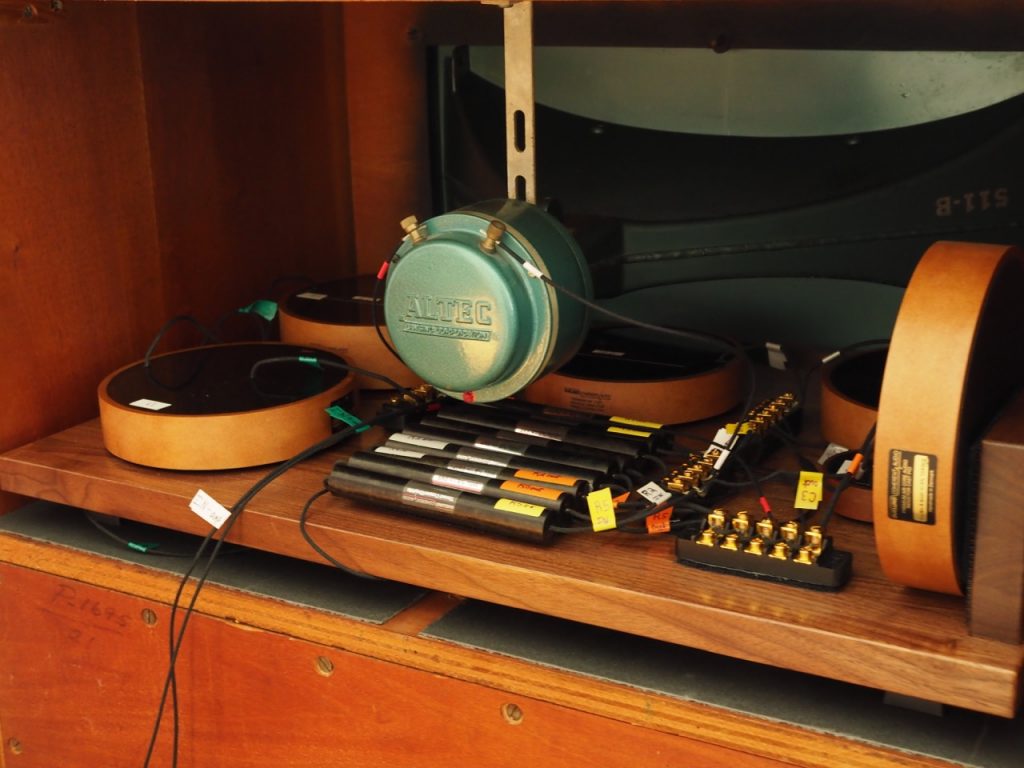
Duelund CAST tinned-copper crossovers in the "Stokowski" Altec loudspeakers.
I then listened to the 45 EVO with my vintage Altec A5 Voice of the Theatre loudspeakers in my audio-visual system (below), and I again experienced that combination of highly-sensitive loudspeakers and 45 SET amplification that made watching videos an exciting, engrossing, and immersive experience.
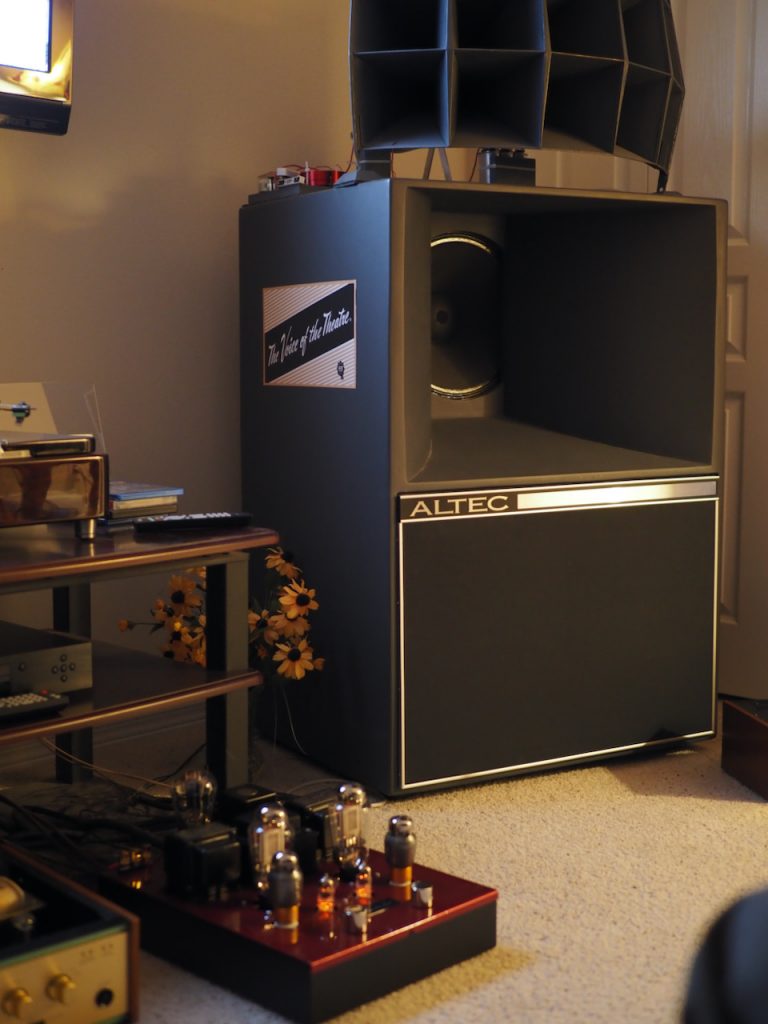
Triode Lab 45 EVO SET integrated amplifier with Altec A5 Voice of the Theatre loudspeakers.
There's something really special and visceral about an SET and Altec A5 video experience, and it hearkened me back to the days of my youth, when the small-town American movie theaters still used Altec A5 loudspeakers powered by Western Electric 91-A amplifiers.
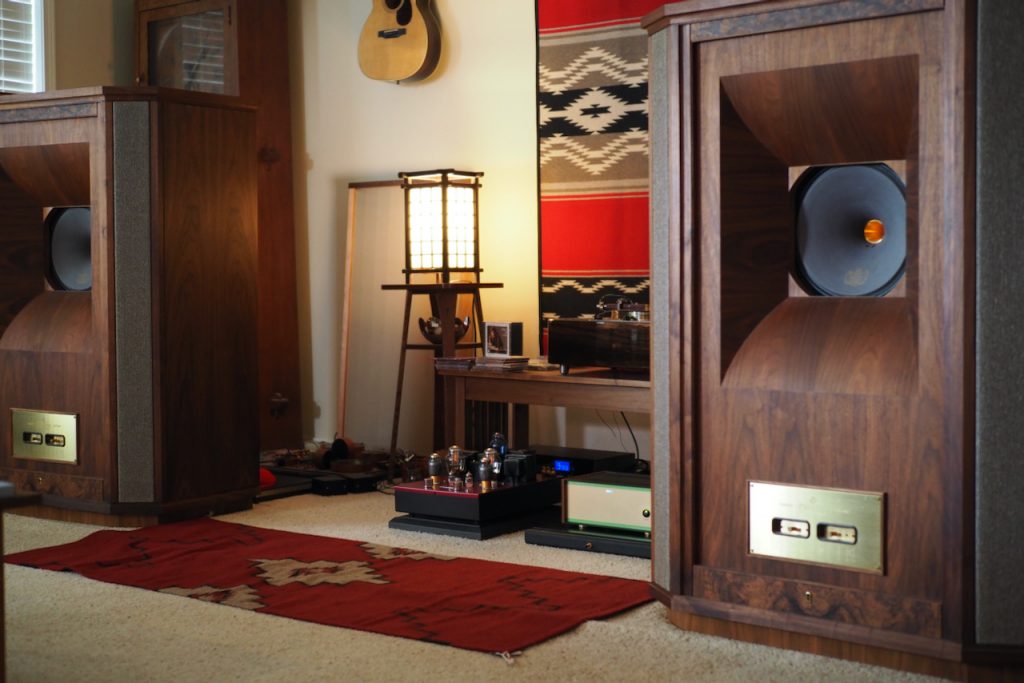
Westminsters powered by the Triode Lab 45 EVO SET integrated amplifier.
Finally, I listened to the Triode Lab 45 EVO SET integrated amplifier in my main music system with my Duelund-ized Tannoy Westminster Royal SE loudspeakers (below), and all of my listening impressions described below are from that system context.
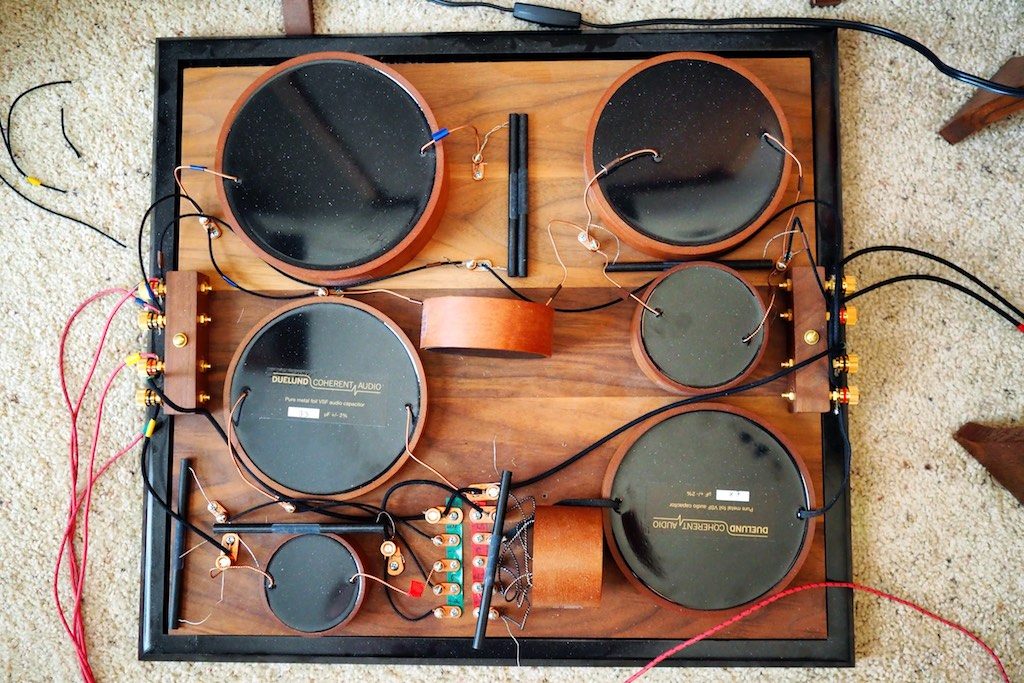
Duelund CAST crossover for Tannoy Westminster loudspeaker.
As Tannoy Westminster Royal SE loudspeakers owners' will tell you, the high-frequency horn of the 15-inch dual concentric driver is extremely revealing, which is why they are used by a number of electronics designers for evaluating their amplifier designs (e.g. Nelson Pass and Wayne Colburn of Pass Labs and First Watt fame both use Tannoy 15-inch dual concentric drivers in custom cabinets for evaluating new designs).
I might also add that the Duelund CAST crossovers (above) of my Westminsters use pure silver Duelund CAST capacitors in the high-frequency circuit, which are extremely revealing, giving a very clear view into upstream components' performance.
For an analog source I used my Classic Turntable Company hot-rodded Garrard 301 in an Artisan Fidelity plinth (below).
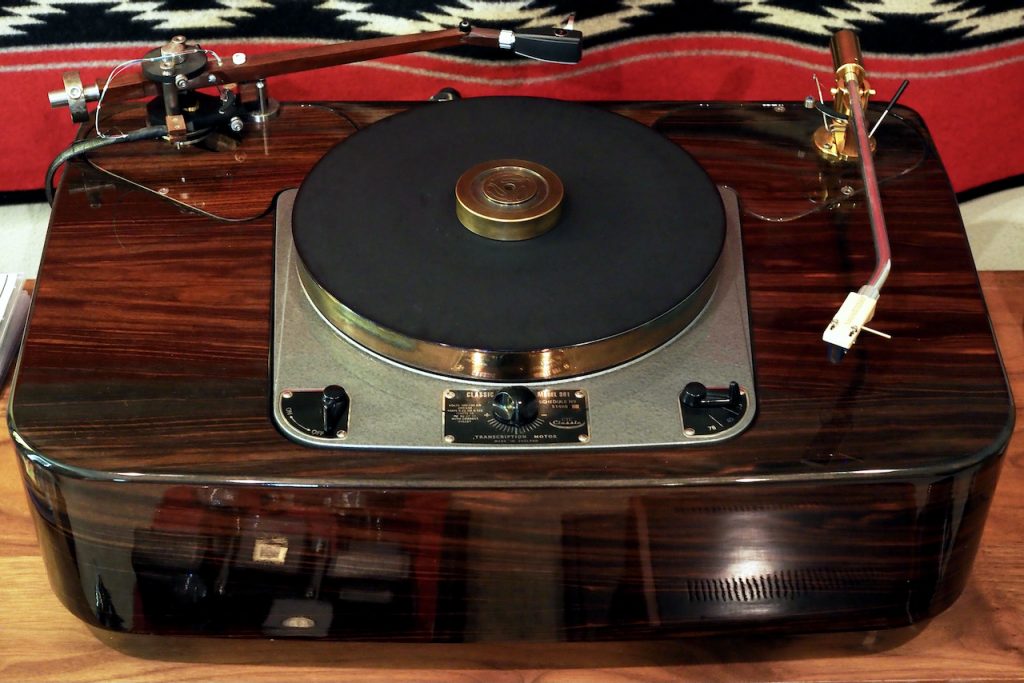
All of my listening impressions were with my Thomas Schick tonearm mounted with an Audio Note (UK) Io I moving-coil phonograph cartridge (photo below), which I'll be writing a Positive Feedback feature review about in the not too distant future.
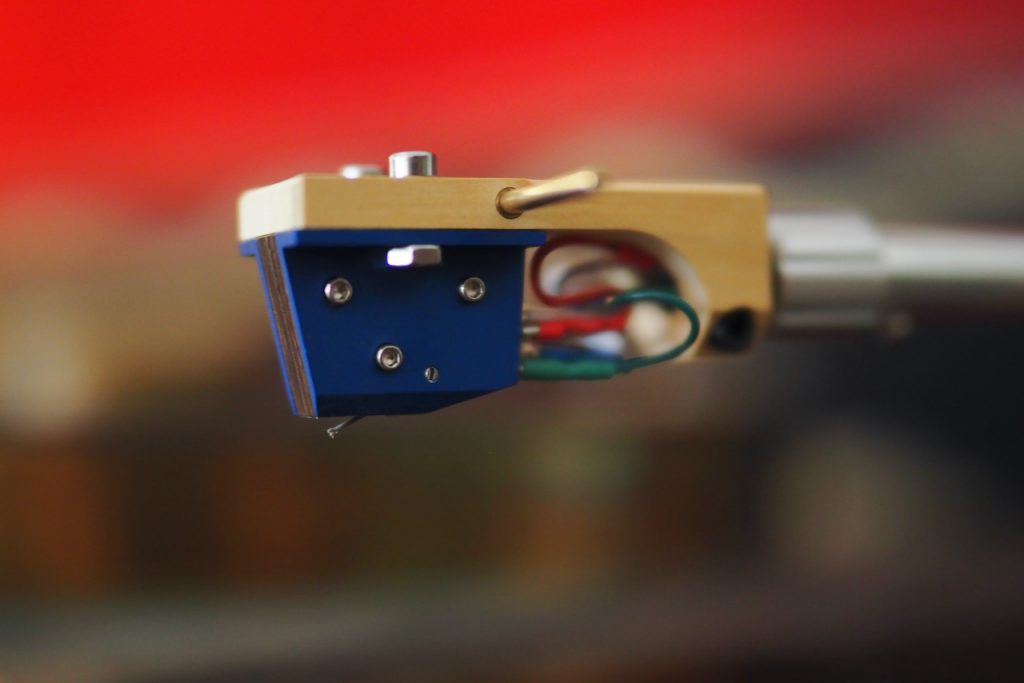
Audio Note (UK) Io I moving coil phonograph cartridge.
If you read my review of Pass Labs XP-17 phono equalizer (HERE) you can get a preview of sorts of the performance of the Audio Note (UK) Io I moving-coil cartridge—it is superb.
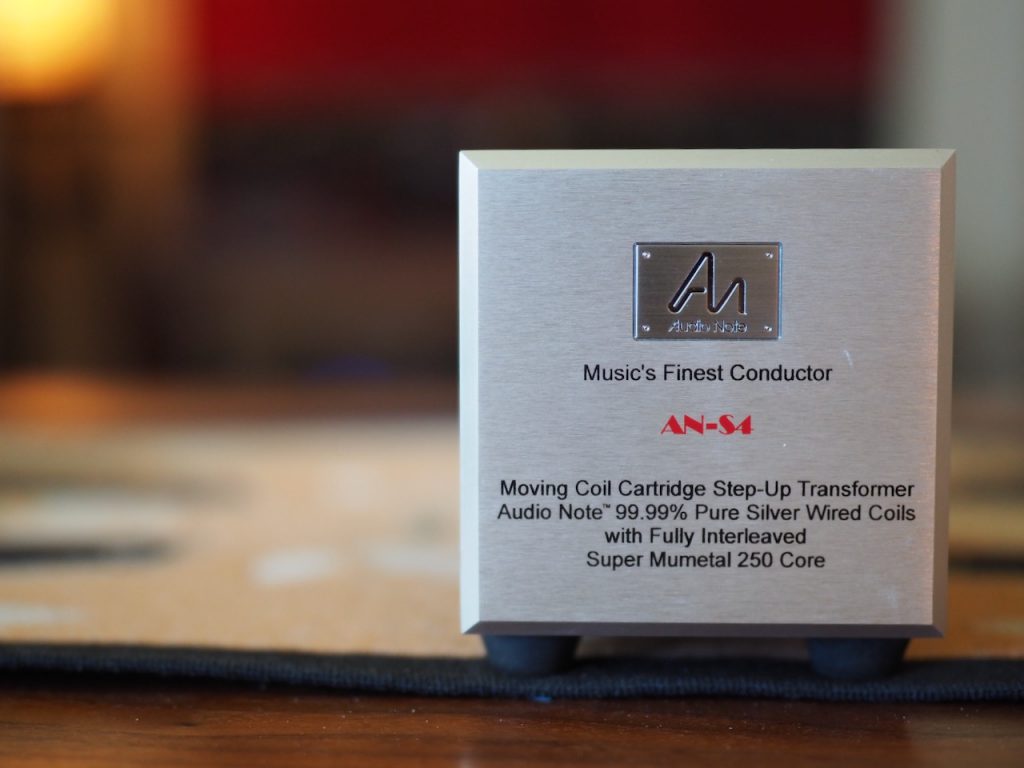
Audio Note (UK) AN-S4 step-up transformer (SUT).
The Audio Note (UK) Io I moving-coil phonograph cartridge was stepped up with an Audio Note (UK) AN-S4 step-up transformer (SUT)—review to come (photo above).
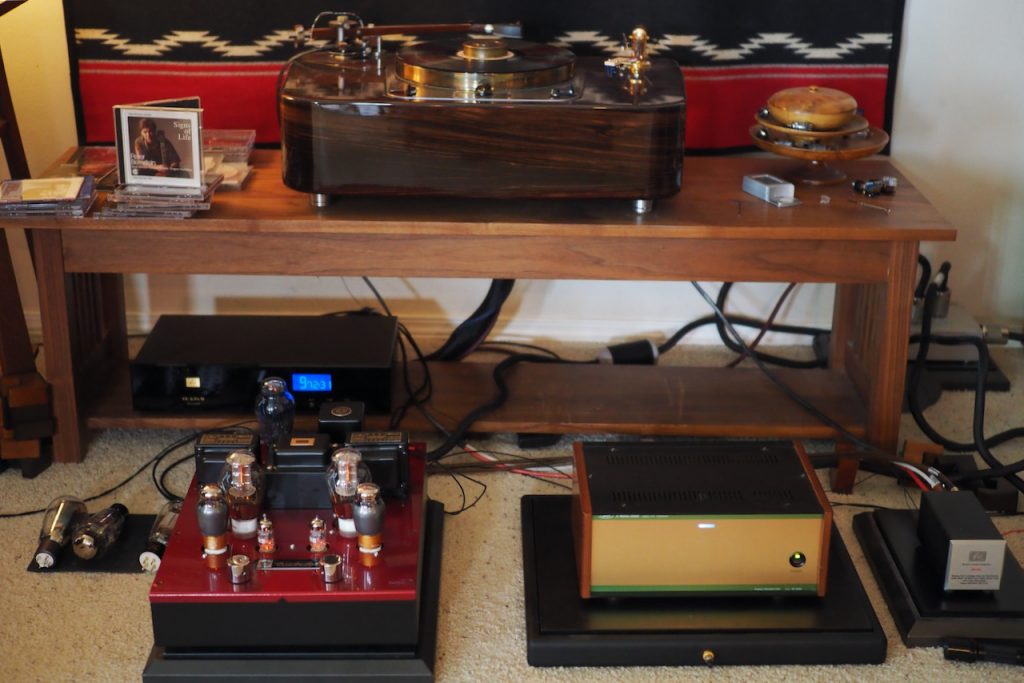
Triode Lab 45 EVO SET integrated amplifier (left), Audio Note (UK) CD (back middle), Leben RS-30EQ (middle right), and Audio Note (UK) AN-S4 step-up transformer (right).
Phono equalization was performed by the Leben RS-30EQ. To connect the AN-S4 SUT to the Leben RS30-EQ, and the RS-30EQ to the Triode Lab 45 EVO integrated amplifier, I used the shielded Belden 8402 tinned-copper microphone cable interconnects, which are longtime favorites of mine, due to their exquisitely balanced musicality and sonic prowess.
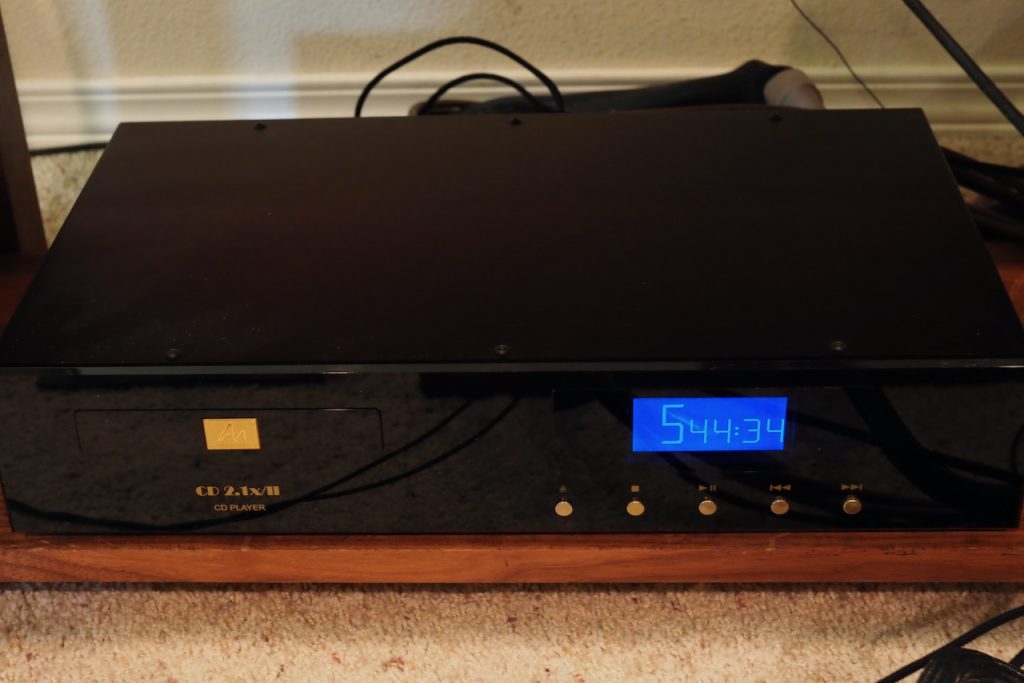
I used the superb Audio Note (UK) CD 2.1x/II Level Two Red Book CD player as a digital source (review HERE), along with Duelund DCA16GA tinned-copper interconnects terminated with plastic-free Duelund RCAs - a particularly synergistic match - to connect it to the Triode Lab 45 EVO integrated amplifier.
The power cords used for the Leben RS-30EQ and the Triode Lab 45 EVO SET integrated amplifier were the Acoustic Revive 'Absolute' power cords, and for the Audio Note (UK) CD 2.1x/II Level Two Red Book CD player I used a Sablon Audio 'Robusto' power cord.
To connect the Triode Lab 45 EVO SET integrated amplifier to my Duelund-Westminster Project (HERE) Tannoy Westminster Royal SE loudspeakers I used Duelund DCA16GA tinned-copper speaker cables.
Listening Impressions
Ok, that's all for now. Check back in the next few weeks for the full article about the Triode Lab 45 EVO single-ended-triode integrated amplifier at Positive Feedback.
As always, thanks for stopping by, and may the tone be with you!



























